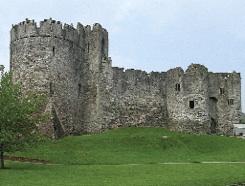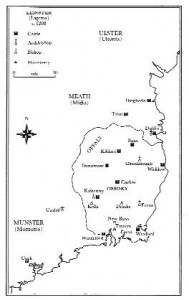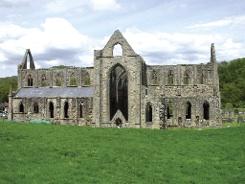A medieval ‘power couple’:
Published in Early Modern History Social Perspectives, Features, Issue 2 (March/April 2010), Medieval History (pre-1500), Volume 18
Chepstow Castle—Isabel and William’s Welsh power base. (Jeff Thomas)
In the late twelfth-century Anglo-Norman marriage market, the teenage Isabel de Clare was a very desirable prize. Under Anglo-Norman feudal law, the marriage of her parents, Strongbow and Aoife, and the related succession agreement between Strongbow and Isabel’s maternal grandfather, Diarmait Mac Murchada, united the holdings of the two families. But when Strongbow died in 1176 there was no adult heir, so the Crown assumed responsibility for the interim administration of the estates. As a widow, Aoife was not without consequence. In accordance with feudal custom, she was entitled to the use of one-third of the estates Strongbow possessed at the time of their marriage. The royal records indicate that she exercised this right in respect to lands in both England and Wales. Indeed, there is a suggestion that she was assigned the responsibilities of a military commander in Wales in 1183–4. Since her daughter Isabel was a royal ward, it was the king’s prerogative to select a suitable husband.
Enter William Marshal

Leinster c. 1208—the Mac Murchada power base roughly corresponded to the modern counties of Wexford and Carlow. (David Crouch)
William Marshal was born around 1147. His family connections facilitated a military education in Normandy, where he was knighted in 1166. From then on he earned his living as a professional soldier, supplementing his income on the competitive tournament circuit. He entered royal circles around 1168, catching the eye of Eleanor of Aquitaine, the legendary wife of Henry II. In 1170 he moved to the court of her son, also named Henry, even joining him in his failed rebellion. After the young Henry’s death in 1176, William went on crusade to the Holy Land. On returning home, he joined the senior Henry’s service. Bygones were bygones.
Given the unsettled nature of the times, there were many opportunities for William to display his loyalty and military mettle. At one point he even unhorsed another rebellious son, the future Richard the Lionheart, in battle. When Henry died in 1189, William again demonstrated his ability to navigate turbulent waters. Richard, Henry’s successor, may have been embarrassed by the memory of their battlefield encounter, but he was shrewd enough to recognise a good thing. Accordingly, William was welcomed into the inner circle. To cement the allegiance, Richard acted on a promise of his father, Henry: William was to have the hand of Isabel de Clare in marriage.
The combination of Isabel’s inherited wealth and William’s earned status made for a fortuitous pairing. To borrow a modern phrase, they became very much the medieval ‘power couple’. Like her mother, Isabel was marrying a considerably older man, one well versed in the machinations of the medieval world. From what can be gleaned, the marriage was successful at a personal level. They were to have ten children, five boys and five girls, and there is no hint of there ever being any estrangement between them. Further, the evidence suggests that Isabel’s influence and role went beyond the business of simply providing heirs.
Consolidation of family power
The first half of their 30-year marriage was characterised by reassertion and consolidation of family power. As not all of Isabel’s inheritance became immediately available, their main base was initially centred on Chepstow in south-east Wales. The rest took a little time. Leinster had been in the custody of Richard’s younger brother, John, and he was initially reluctant to give it up. After a year of waiting, William had to solicit the king’s intervention to effect the handover. But even then there was the matter of exerting effective control. After all, Strongbow had been dead for fourteen years, and absentee lordships could be very vulnerable. Indeed, it was to be more than a decade before the family inheritance in Ireland was fully under control.
As for England, the choicest part of the inheritance remained in Aoife’s hands until her death. Still, there were other accumulations. In late 1189 Richard granted William half of the Giffard lordship in Normandy and England. Then, on the death of William’s older brother in 1194, the (relatively modest) Marshal family lands in England were added. But something more significant was still to come. When Richard died without an heir in 1199, there were two contenders for the royal succession. One was John, Richard’s younger brother. The other was Arthur, the son of Richard’s dead older brother. In keeping with his status and profile, William was one of the critical players in selecting John. Doubtless in gratitude, John restored the earldom of Pembroke to the family. Although originally created for Strongbow’s father in 1138, Henry had withheld the earldom from Strongbow. With its return, the family’s holdings in Wales were effectively tripled. Geographically, Pembroke’s coastal location on the Irish Sea provided the ideal staging post for re-establishing effective control over Leinster. Still, while Isabel and William visited Leinster in 1200–1, it was to be several more years before they truly got a grip. In the meantime, the family fell out of royal favour.
In 1203, John lost Normandy to Philip of France. Moving quickly to consolidate his position, Philip required landholders to do him homage or forfeit their Norman holdings. With John’s permission, William did this in 1205. But the specifics of the oath caused a problem. At Philip’s insistence, the homage was to be exclusive, a factor which had the effect of making William Philip’s man as far as France was concerned. In practical terms, it meant that he could no longer take up arms against Philip in Normandy. From William’s perspective, this may not have been an issue. After all, John had already lost Normandy to Philip. But to John, who intended to forcibly recover his Continental possessions, it was tantamount to betrayal.
Return to Leinster

Tintern Abbey in Wales—burial place of Isabel and her mother Aoife. (Jeff Thomas)
Isabel and William returned to Leinster in 1207, arriving in February or March. They quickly found themselves facing two challenges. First, there was the practical need to re-establish the family authority that had languished in the absentee years since Strongbow’s death. Second, there was the meddling of their estranged sovereign.
The principal instrument of both challenges came in the person of Meilyr fitz Henry. Meilyr had two motivations. As a veteran of Strongbow’s Leinster campaigns in the 1170s, he would naturally see William as an undeserving parvenu. And as the royal justiciar in Ireland he was John’s man. When John recalled William to England, the trap was set. Along with the other Anglo-Norman barons summoned from Ireland, William and Meilyr presented themselves at court in October 1207. Once they were there, John went to work, alienating the barons from William via grants of land and titles. Meanwhile, back in Leinster, Meilyr’s men raided New Ross. The intended coup de grâce came when John granted Meilyr permission to return to Ireland in January 1208, while William was kept on in England.
But without a royal army to back it up, the plot didn’t work. Wary of what would happen in his absence, William had left Isabel and most of his knights in Leinster. Further, an understanding had been reached with the de Lacys of Ulster and Meath, and Meilyr quickly fell to the resulting military coalition. Captured, he handed over his son as a hostage for future good behaviour. The crisis was essentially over, and Isabel’s Leinster inheritance was secured. As for relations with the king, William and John patched things up.
It was in Leinster that Isabel’s influence was most clearly felt. As daughter of Strongbow and granddaughter of Diarmait, she was the key to legitimacy there. According to David Crouch, ‘her advice and consent was both needed and sought’. Displaying a keen sense of reality, she was a sceptic with respect to the king’s intentions. Indeed, she had been opposed to an earlier decision to deliver their second son to John as a hostage. And in William’s absence, it was to her that the defeated Meilyr made his act of submission.
For the next few years, Isabel and William spent most of their time in Leinster, with Kilkenny as their base. It was a busy period, focused on development of the territory and consolidation of family power. Particular attention was paid to Kilkenny and New Ross, with emphasis on developing the latter as a deep-water port. There was also the necessary business of rewarding friends and punishing enemies. Key supporters during the crisis of 1207–8 were recognised, as the current Mallardstown (for the grant to William Mallard) and Earlytown (for the grant to John of Earley) attest. Those who had been disloyal were often marginalised, Meilyr being the most prominent case in point. For him, the price paid involved handing over his castle at Dunamase and pledging the surrender of his lands after his death. In a harsh world, William and Isabel knew how to play the game.
William appointed regent

As befits his status and Templar affiliation, William is buried in the Temple Church, London. (Bill Tyne)
As John’s reign sputtered towards an end, the royal situation became increasingly precarious. Accordingly, William was recalled to England in 1213 to lend assistance, assuming the role of chief defender of the king in the struggle with the rebel barons. But John’s position was beyond repair, and even the concessions of Magna Carta couldn’t stem the revolt. To make matters worse, the rebels offered the crown to Louis, son of Philip of France, who duly appeared in England at the head of an army. Of the Anglo-Norman magnates, only William and the earls of Chester, Derby and Warwick stood with the king. Then in October 1216 John fell ill and died.
In the ensuing uncertainty, John’s nine-year-old son was crowned Henry III, with William being appointed regent. Power was to be exercised in conjunction with the papal legate. Over the next year, a mixture of negotiation and military pressure brought the rebellion to a close. As for Louis, he returned to France, leaving the husband of Diarmait Mac Murchada’s granddaughter as the de facto ruler of the Anglo-Norman world. He continued in this role for more than eighteen months after Louis left England.
Death
Eventually, though, age and illness took their toll. After more than 70 years of good health, William fell ill in January 1219, finally handing over the reins of government in April. Then he made his will, said goodbye to Isabel and their daughters, and joined the Templars. (As a member of that order, he was required to forego the company of women.) He died on 14 May 1219. While William’s will designated their two oldest sons as ultimate prime beneficiaries, all the lands that Isabel had inherited reverted to her for the rest of her life. She moved quickly to fill the void, asserting her rights in England, Wales and Ireland, and travelled to France to do homage to Philip for her Norman lands. But within a year she too was dead, on 9 March 1220.
The aggregation of power and influence created by Isabel and William was of remarkably short subsequent duration. While all five sons grew into adulthood, none lived past 45, nor did they have any children. As the male line vanished, the lands were partitioned between the families into which their daughters had married.
Although close throughout their 30-year married life, Isabel and William remained separated in death. As befits his status and Templar affiliation, he is buried in the Temple Church in London, while she is buried in Tintern Abbey in Wales, close to her mother, Aoife. The abbey itself has a family connection, having been founded in 1131 by Walter de Clare. But there is a possible Irish connection for Isabel’s remains. A cenotaph discovered in the churchyard of St Mary’s in New Ross, Co. Wexford, carries the words Isabel Laegn (Isabel of Leinster). It has been suggested that the cenotaph was more than a monument—that it in fact marked the burial place of Isabel’s heart. HI
Pat Murphy is a history and economics graduate from University College Dublin now living in Toronto, Canada.
Further reading:
C.A. Armstrong, William Marshal, earl of Pembroke (Kennesaw, 2007).
D. Crouch, William Marshal (New Jersey, 2002).
M.T. Flanagan, Irish society, Anglo-Norman settlers, Angevin kingship (Oxford, 1989).
N. Furlong, Diarmait, king of Leinster (Cork, 2006).
















